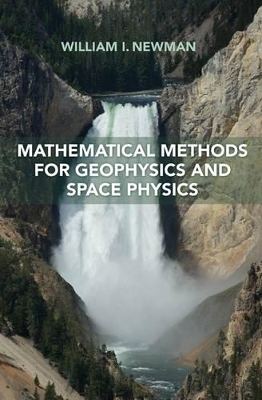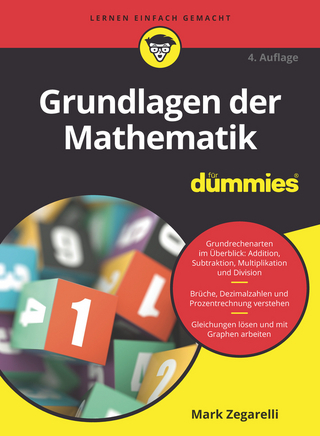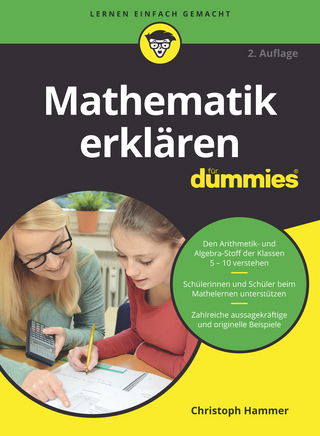
Mathematical Methods for Geophysics and Space Physics
Princeton University Press (Verlag)
978-0-691-17060-2 (ISBN)
Proven in the classroom, Mathematical Methods for Geophysics and Space Physics features numerous exercises throughout as well as suggestions for further reading. * Provides an authoritative and accessible introduction to the subject * Covers vector and tensor analysis, ordinary differential equations, integrals and approximations, Fourier transforms, diffusion and dispersion, sound waves and perturbation theory, randomness in data, and a host of other topics * Features numerous exercises throughout * Ideal for students and researchers alike * An online illustration package is available to professors
William I. Newman is professor in the Department of Earth, Planetary, and Space Sciences, the Department of Physics and Astronomy, and the Department of Mathematics at the University of California, Los Angeles. He is the author of Continuum Mechanics in the Earth Sciences.
Preface ix 1 Mathematical Preliminaries 1 1.1 Vectors, Indicial Notation, and Vector Operators 1 1.2 Cylindrical and Spherical Geometry 6 1.3 Theorems of Gauss, Green, and Stokes 10 1.4 Rotation and Matrix Representation 11 1.5 Tensors, Eigenvalues, and Eigenvectors 15 1.6 Ramp, Heaviside, and Dirac delta Functions 19 1.7 Exercises 20 2 Ordinary Differential Equations 23 2.1 Linear First-Order Ordinary Differential Equations 25 2.2 Second-Order Ordinary Differential Equations 30 2.2.1 Linear Second-Order Differential Equations 33 2.2.2 Green's Functions 34 2.2.3 LRC Circuits and Visco-Elastic Solids 38 2.2.4 Driven Oscillators, Resonance, and Variation of Constants 39 2.2.5 JWKB Method, Riccati Equation, and Adiabatic Invariants 43 2.2.6 Nonlinearity and Perturbation Theory 47 2.3 Special Functions, Laplacians, and Separation of Variables 52 2.3.1 Cartesian Coordinates and Separation of Variables 53 2.3.2 Polar and Cylindrical Coordinates and Separation of Variables; Bessel and Generating Functions 54 2.3.3 Spherical Coordinates and Separation of Variables; Green's and Generating Function; Spherical Harmonics 59 2.4 Nonlinear Ordinary Differential Equations 69 2.4.1 Bullard's Homopolar Dynamo 69 2.4.2 Poincare-Bendixson Theorem and the Van der Pol Oscillator 71 2.4.3 Lorenz Attractor, Perturbation Theory, and Chaos 74 2.4.4 Fractals 78 2.4.5 Maps and Period Doubling 82 2.5 Exercises 89 3 Evaluation of Integrals and Integral Transform Methods 96 3.1 Integration Methods, Approximations, and Special Cases 97 3.1.1 Elementary Methods and Asymptotic Methods 97 3.1.2 Steepest Descent Methods 101 3.1.3 Special Problems in Geophysics; Elliptic Integrals 103 3.2 Complex Analysis and Elementary Contour Integration 104 3.3 Fourier Transforms and Analysis Methods 113 3.3.1 Fourier Series, Transforms, and Convolutions 113 3.3.2 Illustrative Examples of Fourier Transform Pairs 115 3.3.3 Multidimensional and Other Fourier Transform Pairs 119 3.3.4 Sampling Theorem, Aliasing, and Approximation Methods 126 3.3.5 Fast Fourier Transform 131 3.4 Inverse Theory, Calculus of Variations, and Integral Equations 134 3.4.1 Linear Inverse Theory 135 3.4.2 Abel Transform 136 3.4.3 Radon Transform 138 3.4.4 Calculus of Variations 139 3.4.5 Herglotz-Wiechert Travel-Time Transform 140 3.5 Exercises 146 4 Partial Differential Equations of Mathematical Geophysics 151 4.1 Introduction to Partial Differential Equations 151 4.1.1 Classification of Partial Differential Equations and Boundary Condition Types 151 4.1.2 Wave Equation in One Dimension 155 4.1.3 Elements of Fluid Flow 159 4.2 Three-Dimensional Applications 164 4.2.1 Diffusion Equation in Three Dimensions 165 4.2.2 Wave Equation in Three Dimensions 166 4.2.3 Gravitational Potential and Green's Function Methods 170 4.3 Diffusion, Dispersion, Perturbation Methods, and Nonlinearity 172 4.3.1 Diffusion and Dispersion 172 4.3.2 Sound Waves and Perturbation Theory 180 4.3.3 Burgers's Equation and Solitary Waves 182 4.3.4 Korteweg-de Vries Equation and Solitons 184 4.3.5 Self-Similarity, Scaling, and Kolmogorov Turbulence 191 4.4 Exercises 193 5 Probability, Statistics, and Computational Methods 202 5.1 Binomial, Poisson, and Gaussian Distributions 203 5.1.1 Binomial Distribution 208 5.1.2 Poisson Distribution 209 5.1.3 Normal Distribution 211 5.2 Central Limit Theorem 214 5.3 Randomness in Data and in Simulations 217 5.3.1 Regression and Fitting of Experimental Data 217 5.3.2 Random Number Generation and Monte Carlo Simulation 219 5.4 Computational Geophysics 221 5.4.1 Computation, Round-off Error, and Seminumerical Algorithms 221 5.4.2 Roots of Equations 223 5.4.3 Numerical Solution of Ordinary Differential Equations 226 5.4.4 General Issues in the Numerical Solution of Partial Differential Equations 233 5.4.5 Numerical Solution of Parabolic Partial Differential Equations 234 5.4.6 Numerical Solution of Hyperbolic Partial Differential Equations 236 5.5 Exercises 238 References 241 Index 247
| Erscheinungsdatum | 07.05.2016 |
|---|---|
| Zusatzinfo | 42 line illus. |
| Verlagsort | New Jersey |
| Sprache | englisch |
| Maße | 178 x 254 mm |
| Gewicht | 567 g |
| Themenwelt | Mathematik / Informatik ► Mathematik ► Allgemeines / Lexika |
| Naturwissenschaften ► Geowissenschaften ► Geophysik | |
| Naturwissenschaften ► Physik / Astronomie ► Astronomie / Astrophysik | |
| ISBN-10 | 0-691-17060-6 / 0691170606 |
| ISBN-13 | 978-0-691-17060-2 / 9780691170602 |
| Zustand | Neuware |
| Haben Sie eine Frage zum Produkt? |
aus dem Bereich


